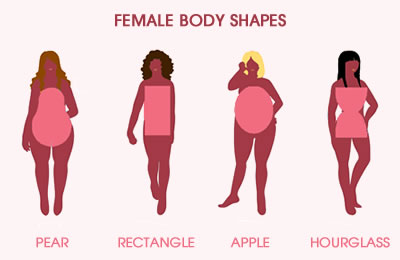MTF Surgery Procedures » Body Feminization
Body Feminization Surgery Explained
What Is Body Feminization Surgery?
Body Feminization Surgery (BFS) is a group of procedures that feminize body contours for trans women who feel they didn't get enough feminization from Estrogen and lifestyle changes alone. Body Feminization is often performed in tandem with Facial Feminization or Breast Augmentation.
While many trans women are satisfied with the body shape changes that are acquired through hormone therapy, others don't achieve the level of feminization desired, which can negatively affect body image, self-esteem and confidence. Body Feminization Surgery provides a solution for feminizing body shape when hormones, diet and exercise fall short.
The "Ideal" Female Body Shape
While there is no single type of body composition that describes the "ideal" female physique—which is highly subjective—the concept of the ideal female body shape can still be helpful as a reference when considering the goals and benefits of Body Feminization Surgery.
The female body shape has been categorized by researchers into four distinct types:
- Pear shape: Hip width is greater than bust; weight carried predominantly in the hips, buttocks and thighs.
- Rectangle shape: Even fat distribution through waist, buttocks, chest and face.
- Apple shape: Shoulders wider than hips, large bust, less defined waist, narrower hips, small thighs; weight carried predominantly in face, bust and belly.
- Hourglass shape: Very narrow waist; fat distributed equally between the upper and lower body.
 Achieving a female body shape can be challenging for some trans women. Hormone therapy and Breast Augmentation, combined with a smart diet and exercise, is often the best approach for developing a more feminine physique. Still, many trans women will find that some body contours are near-impossible to feminize without surgical intervention.
Achieving a female body shape can be challenging for some trans women. Hormone therapy and Breast Augmentation, combined with a smart diet and exercise, is often the best approach for developing a more feminine physique. Still, many trans women will find that some body contours are near-impossible to feminize without surgical intervention.
The sex hormone differences between men and women are to blame.
Generally, women carry more body fat than men, and it tends to be in the hips, buttocks and thighs, creating the curves associated with a feminine body. Men usually carry extra weight in the upper body, predominantly the abdomen.
As a consequence, many transgender women also carry extra weight in ways that can highlight a masculine physique. It's not surprising then that Body Feminization Surgery is increasingly considered a necessary part of male to female gender reassignment surgery.
Areas That Can Be Treated to Achieve a More Feminine Body Shape
The goal of Body Feminization Surgery is to create and accentuate more feminine curves using Liposuction and Fat Grafting. The areas commonly treated to achieve this are:
- Breasts (see Breast Augmentation)
- Waist and hips (to achieve classic waist-to-hips ratio)
- Buttocks
- Abdomen (Abdominoplasty or "tummy tuck")
Multiple areas can be treated in one surgery. Body Feminization Surgery typically includes Trunk Liposuction combined with Buttock Augmentation.
Trunk Liposuction: Lowers the waist-to-hip ratio with a tapered waist and curved, feminine hips--essential characteristics of the "hourglass" feminine body shape.
Brazilian Butt Lift: Creates shapely buttocks without the use of buttock implants! Instead, fat is liposuctioned from other areas of the body, such as the waist, is transferred to the buttocks. The procedure is ideal for trans women as it improves the shape and projection of the buttocks while reducing fat from where it is unwanted and using it to create a curvier, more feminine body contour.
Body Feminization = Liposuction
Body Feminization Surgery is performed using Liposuction, a safe procedure that suctions and removes fat from targeted areas. Liposuction is performed on an outpatient basis, under general anesthesia or local anesthesia with twilight sedation. A 3.7-5mm diameter hollow tube (cannula) is inserted through small, strategically placed incisions and vacuum is applied to break up and suction out fat. (Liposuction is considered a nearly scar-less procedure because the incisions are so small.) Surgery time depends on the number and size of areas being treated but is generally 1-2 hours in duration.
SmartLipo vs. Lipo
SmartLipo is an advanced method of Liposuction that uses lasers and offers better results and is tolerated by patients better than traditional Liposuction. SmartLipo was the first laser to be approved by the FDA in 2006 to be used for laser-assisted liposuction. SmartLipo allows more effective removal of fat while minimizing trauma to surrounding tissues. SmartLipo uses two separate laser wavelengths to emulsify fat and improve skin tightening by stimulating the production of collagen. SmartLipo Triplex uses a third laser wavelength to reduce bleeding and post-operative bruising. The gentler process of SmartLipo vs. traditional liposuction results in a better experience and recovery for patients.
 Dr. Mark Youssef, Director of the Transgender Surgery Institute of Southern California, is a Cosmetic Surgeon in Santa Monica who helps clients on the trans feminine spectrum with Breast Augmentation, Body Feminization and Facial Feminization surgeries. Ask Dr. Youssef if SmartLipo would be a good choice for you.
Dr. Mark Youssef, Director of the Transgender Surgery Institute of Southern California, is a Cosmetic Surgeon in Santa Monica who helps clients on the trans feminine spectrum with Breast Augmentation, Body Feminization and Facial Feminization surgeries. Ask Dr. Youssef if SmartLipo would be a good choice for you.
SAFELipo vs. Lipo
SAFELipo combines elements of liposuction, fat shifting, and fat grafting surgeries into a 3-step process that offers better contour compared to traditional Liposuction. Power-assisted liposuction (PAL) is used to separate fat, emulsify and remove it without damaging the surrounding tissue. Next, the thin layer of fat left behind is evened out using fat equalization probes. This extra step helps to avoid contour irregularities.
 Dr. Joel Beck is a board-certified plastic and reconstructive surgeon in Charlotte NC who has been performing gender-affirming surgery since 2003. If you're considering Body Feminization Surgery, contact Dr. Beck to find out if SAFELipo is right for you.
Dr. Joel Beck is a board-certified plastic and reconstructive surgeon in Charlotte NC who has been performing gender-affirming surgery since 2003. If you're considering Body Feminization Surgery, contact Dr. Beck to find out if SAFELipo is right for you.
SmartLipo vs. SAFELipo: Which Is Better?
SAFELipo has the advantage of preserving the fat cells, which can then be re-injected to optimize the curves of other areas of the body such as the breasts or buttocks (fat grafting.) However, the most critical factor in choosing between traditional Liposuction, VASER Hi-Definition Liposuction (ultrasound), SmartLipo and SAFELipo is—and this cannot be emphasized enough—the experience and skill that the surgeon has with the chosen technique.
Ideal Candidates for Body Feminization Surgery
Not all trans women are good candidates for Body Feminization Surgery. It's important to note that BFS is not intended to be a substitute for maintaining a good diet and getting regular exercise. Healthy transgender women who are close to their ideal body weight, have good muscle tone and no excess, sagging skin, but also have fat that has not responded to weight loss strategies are ideal candidates for Body Feminization.
Post-Op and Recovery from Body Feminization Surgery
After surgery, patients are fitted with a compression garment. Typically, the compression garment is worn 24/7, with a break for showering, for about 4 weeks. Depending on which areas were treated, patients may also have Jackson-Pratt drains.
What to expect after Body Feminization Surgery:
- General discomfort, mild-to-moderate pain
- Swelling, may persist for weeks
- Bruising
Tips for recovering after Body Feminization Surgery:
- Bed rest and limited activity for a few days after surgery; pain should significantly reduce 4-5 days post-op. Light walking is recommmended.
- Take pain medication, if needed (being in pain makes it harder to heal.)
- Take the antibiotics you are prescribed to reduce risk of infection
- Resume light physical activity after a week
- Avoid heavy lifting and more strenuous exercise for at least four weeks, possibly longer depending on the size and number of areas treated.
- Talk to your surgeon about Arnica homeopathic remedies, bromelain and other supplements to reduce swelling and bruising after surgery.
Follow-up appoinments with your surgeon will take place one day after surgery and then typically at one week and one month after surgery, and possibly at longer intervals if the patient is local to the surgeon.
Important Considerations
| Temporary Side Effects | Rare Complications |
|---|---|
| Mild-to-moderate discomfort Bruising Swelling |
Infection Fluid build-up (Hematoma, Seroma) Nerve damage Blood clots |
As a surgical procedure, Liposuction is considered very safe however all surgeries carry potential risks. That said, many complications can be avoided by following the pre- and post-operative instructions.
Fat removal is permanent, but patients must have a healthy diet and exercise habits to maintain results.
Some patients may require a revision to treat loose skin, uneven contours, or lumpy/dimpled results.
Finally, while Body Feminization Surgery can provide a more feminine appearance, results may not be "perfect". It's very important for patients to have realistic expections about outcomes.
What to Expect at Your Consultation
- Review of your health history, including previous surgeries, drug sensitivities, daily habits and lifestyle.
- Discussion about the procedure(s) you are interested in, including risks and expected outcomes.
- Evaluation of your body contours, including excess skin, fat deposits, muscle tone. Measurements may be taken.
How Much Does Body Feminization Cost?
The cost of Body Feminization Surgery is dependent on the size and number of areas being treated. Fees often include the surgeon's fee, Anesthesiologist's fee, OR fees, compression garments and follow-up appointments. In general, you can expect cost to be in the range of $3000-$15,000. Discounts may be available if Body Feminization Surgery is being combined with Breast Augmentation or Facial Feminization.
Body Feminization Surgery (BFS) is an ideal procedure for trans women who would like to obtain a more feminine body shape and for whom weight loss strategies and exercise have not helped entirely. BFS can precisely remove and redistribute fat from targeted areas of the body and help match a trans woman's physique to their transition goals. Improved self-esteem and restored confidence are important reasons why Body Feminization Surgery has become an essential stage of transition for many trans women.
Last updated: 04/08/24
